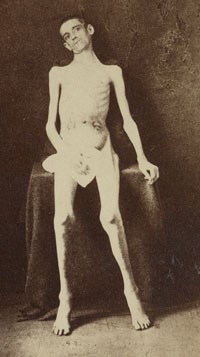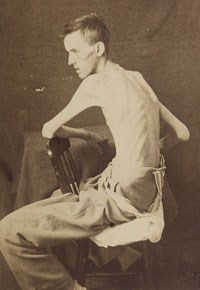
Library of Congress Few images are as synonymous with Andersonville as the photographs of emaciated prisoners; so thin that you can see all of their bones and joints. They often remind us of images we see from the concentration camps of the 1930s and '40s. But who are these men? Are they even Andersonville prisoners? What do these photos tell us about the Civil War prison experience? Although some of these images are 1865 photographs of Andersonville survivors, many of these famous photographs are actually of recently released prisoners from Richmond in early 1864. After the prisoner exchange cartel broke down, large numbers of Union soldiers captured in late 1863 were crammed into warehouses around Richmond and on Belle Isle. This rapid influx overwhelmed the Confederacy's ability to feed them or provide medical care. The Confederate army quickly began to search for a replacement prison and Andersonville was selected in the fall of 1863. Construction on the new prison began in January 1864 and the first prisoners arrived from Richmond in February. These transfers continued throughout the spring of 1864. By April 1864, most of the enlisted prisoners remaining in Richmond were those too sick to move. Many of these sick prisoners were paroled and turned over to Union hospitals for medical care. 
Library of Congress In early May 1864 The Congressional Committee on the Conduct of the War held a series of hearings investigating the treatment of prisoners of war in Richmond. Many of the worst cases of these returned prisoners were photographed and these images were widely distributed as propaganda. The committee reported that: Though nearly all the patients now in the Naval Academy hospital at Annapolis, and in the West hospital, in Baltimore, have been under the kindest and most intelligent treatment for about three weeks past, and many of them for a greater length of time, still they present literally the appearance of living skeletons, many of them being nothing but skin and bone; some of them are maimed for life, having been frozen while exposed to the inclemency of the winter season on Belle Isle… …finding it impossible to describe in words the deplorable condition of these returned prisoners, have caused photographs to be taken of a number of them, and a fair sample to be lithographed and appended to [this] report, that their condition may be known by all who examine it. Today, after 150 years, our memory of Civil War prisons is dominated by Andersonville, and we often assume that all of these photos are of Andersonville survivors. But for Americans in early 1864, it was Richmond that was seen as the worst of the prison sites. These photographs of emaciated prisoners from Richmond remind us that suffering in Civil War prisons was not limited to Andersonville. Starvation, diarrhea, suffering, and death haunted prisoners regardless of when they were captured or where they were held. Photos like these are nearly universal to the prisoner of war experience throughout our history. |
Last updated: July 31, 2022
